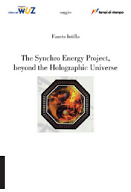Source: Phys.org
---------------------
(Phys.org)—A team of researchers working at the University of Konstanz, in Germany is claiming to have directly sampled electric-field vacuum fluctuations, which would be the first ever made. In their paper published in the journal Science, the team describes an experiment they carried out and a part of it which they claim indicates that they have measured vacuum fluctuations directly for the first time. Theoretical physicists believe that empty space is not empty at all, instead it is filled with quantum particles that pop in and out of existence creating what are known as electric-field vacuum fluctuations. Prior research has led to efforts that have measured such fluctuations indirectly, but no one, until now, has claimed to be able to measure them directly.
The experiment conducted by the team in Germany involved using a long pulse of light to study a shorter pulse of light by firing both through a crystal at the same time. The long pulse had a horizontal polarization while the shorter pulse had a vertical polarization. In such an arrangement, properties of the crystal are dependent on the electric field that exists inside of it, which in turn causes a change in the polarization of the beams that are fired into it and then emerge on the other side. The researchers adjusted the timing of the light pulses to map out fluctuations in the electric field. To offset vacuum fluctuations related to their own existence, they put in just the probe pulse—nothing else. When repeated many times, the researchers found the polarization varied slightly, which the researchers attributed to vacuum fluctuations. To be able to actually see what was going on, the team varied the width and duration of the pulses but not the number of photons in a given beam. They noted that the shot noise should have stayed constant as the pulse grew in size, but it did not, which the team claims was due to electric-field vacuum fluctuations.
Not everyone is convinced—many in the field on reading the paper by the team were quick to point out that variations in the pulse could just as easily have come from something else. Clearly more work will have to be done before the claims made by the team are accepted by the physics community. More information: "Direct Sampling of Electric-Field Vacuum Fluctuations." Science. DOI: 10.1126/science.aac9788
ABSTRACT
The ground state of quantum systems is characterized by zero-point motion. Those vacuum fluctuations are generally deemed an elusive phenomenon that manifests itself only indirectly. Here, we report direct detection of the vacuum fluctuations of electromagnetic radiation in free space. The ground-state electric field variance is found to be inversely proportional to the four-dimensional space-time volume sampled electro-optically with tightly focused few-femtosecond laser pulses. Sub-cycle temporal readout and nonlinear coupling far from resonance provide signals from purely virtual photons without amplification. Our findings enable an extreme time-domain approach to quantum physics with nondestructive access to the quantum state of light. Operating at multi-terahertz frequencies, such techniques might also allow time-resolved studies of intrinsic fluctuations of elementary excitations in condensed matter.




















